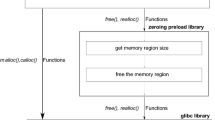Abstract
Increasingly mature cloud computing technology promotes virtual desktop technology, which can solve many problems existing in traditional computing models. However, virtual desktop solutions introduce the thorny problem of how to deliver a real desktop experience to users, as if they are using it locally, especially when playing video. The SPICE (simple protocol for independent computing environments) virtual desktop solution provides several image compression algorithms to address this problem with the purpose of making virtual desktops as real as possible. Although different compression algorithms can contribute their own abilities to different images to a large extent, switching between them is a big problem that consumes a large amount of resources to detect the different type of image and also causes jitter of the virtual desktop. This paper proposes a new solution, called SPICEx, using the JPEG2000 compression algorithm with dynamic compression ratios to solve the problem and finally validates that the performance is better than that of SPICE. With better quality of user experience and also reducing bandwidth consumption, SPICEx solution is meaningful in virtual desktop fields and can be widely used.
Similar content being viewed by others
Explore related subjects
Discover the latest articles and news from researchers in related subjects, suggested using machine learning.References
Redhat. Spice for newbies. http://spice-space.org/docs/spicefornewbies.pdf, 2013
Redhat. Spice protocol. http://spice-space.org/docs/spiceprotocol.pdf, 2013
Yu W, Qiu R, Fritts J E. Advantages of motion-jpeg2000 in video processing. In: Electronic Imaging 2002. 2002, 635–645
De Winter D, Simoens P, Deboosere L, De Turck F, Moreau J, Dhoedt B, Demeester P. A hybrid thin-client protocol for multimedia streaming and interactive gaming applications. In: Proceedings of the 2006 International Workshop on Network and Operating Systems Support for Digital Audio and Video. 2006, 15:1–15:6
Fok F, Lécroart B, Chan E, Simoens P, Dhoedt B. An adaptive approach to optimize thin client protocols. In: Future Network and Mobile Summit, 2010. 2010, 1–9
Tolia N, Andersen D G, Satyanarayanan M. Quantifying interactive user experience on thin clients. Computer, 2006, 39(3): 46–52
Zinca D. Design of a modified RFB protocol and its implementation in an ultra-thin client. In: Proceedings of the 9th International Symposium on Electronics and Telecommunications. 2010, 157–160
Jang S M, Choi W H, Kim W Y. Smart separated software execution system for software as a service. In: Proceedings of the 14th International Conference on Advanced Communication Technology. 2012, 965–970
Liao X, Jin H, Hu L, Liu H. Towards virtualized desktop environment. Concurrency and Computation: Practice and Experience, 2010, 22(4): 419–440
Li J, Jia Y, Liu L, Wo T. Cyberliveapp: A secure sharing and migration approach for live virtual desktop applications in a cloud environment. Future Generation Computer Systems, 2013, 29(1): 330–340
Chen L, Shashidhar N, Liu Q. Scalable secure mjpeg video streaming. In: Proceedings of the 26th International Conference on Advanced Information Networking and Applications Workshops. 2012, 111–115
Information technology — JPEG2000 image coding system: Motion jpeg 2000. 2007, ISO/IEC 15444-3
Deshpande S, Zeng W. http streaming of JPEG2000 images. In: Proceedings of the 2001 International Conference on Information Technology: Coding and Computing. 2001, 15–19
Gormish M, Lee D, Marcellin M. JPEG2000: overview, architecture, and applications. In: Proceedings of the 2000 International Conference on Image Processing. 2000, 2: 29–32
Nieh J, Yang S J, Novik N. Measuring thin-client performance using slow-motion benchmarking. ACM Transactions on Computer System, 2003, 21(1): 87–115
Yang S J, Nieh J, Selsky M, Tiwari N. The performance of remote display mechanisms for thin-client computing. In: Proceedings of the 2002 USENIX Annual Technical Conference on General Track. 2002, 131–146
Author information
Authors and Affiliations
Corresponding author
Additional information
Yuqing Lan received his PhD in 2009. He is now an associate professor in School of Computer Science and Engineering, Beihang University, China, specialized in software engineering and operating system, published 40 papers, 21 of them are included in EI, and 2 of them are included in SCI.
Hao Xu is a graduate student in School of Computer Science and Engineering, Beihang University, China. His research fields are software engineering and cloud computing.
Rights and permissions
About this article
Cite this article
Lan, Y., Xu, H. Research on technology of desktop virtualization based on SPICE protocol and its improvement solutions. Front. Comput. Sci. 8, 885–892 (2014). https://doi.org/10.1007/s11704-014-3410-5
Received:
Accepted:
Published:
Issue Date:
DOI: https://doi.org/10.1007/s11704-014-3410-5




